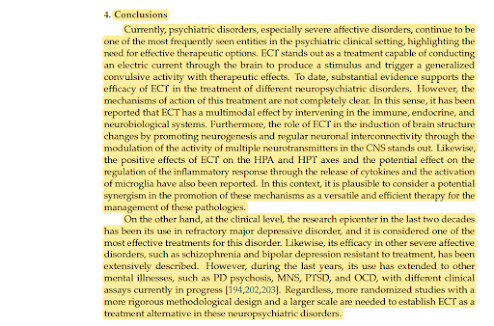Mechanisms of Action of ECT: New Review in International Journal of Molecular Sciences
Out on PubMed, from authors in South America, is this review:
Electroconvulsive Therapy in Psychiatric Disorders: A Narrative Review Exploring Neuroendocrine-Immune Therapeutic Mechanisms and Clinical Implications.

Electroconvulsive therapy (ECT) is based on conducting an electrical current through the brain to stimulate it and trigger generalized convulsion activity with therapeutic ends. Due to the efficient use of ECT during the last years, interest in the molecular bases involved in its mechanism of action has increased. Therefore, different hypotheses have emerged. In this context, the goal of this review is to describe the neurobiological, endocrine, and immune mechanisms involved in ECT and to detail its clinical efficacy in different psychiatric pathologies. This is a narrative review in which an extensive literature search was performed on the Scopus, Embase, PubMed, ISI Web of Science, and Google Scholar databases from inception to February 2022. The terms "electroconvulsive therapy", "neurobiological effects of electroconvulsive therapy", "molecular mechanisms in electroconvulsive therapy", and "psychiatric disorders" were among the keywords used in the search. The mechanisms of action of ECT include neurobiological function modifications and endocrine and immune changes that take place after ECT. Among these, the decrease in neural network hyperconnectivity, neuroinflammation reduction, neurogenesis promotion, modulation of different monoaminergic systems, and hypothalamus-hypophysis-adrenal and hypothalamus-hypophysis-thyroid axes normalization have been described. The majority of these elements are physiopathological components and therapeutic targets in different mental illnesses. Likewise, the use of ECT has recently expanded, with evidence of its use for other pathologies, such as Parkinson's disease psychosis, malignant neuroleptic syndrome, post-traumatic stress disorder, and obsessive-compulsive disorder. In conclusion, there is sufficient evidence to support the efficacy of ECT in the treatment of different psychiatric disorders, potentially through immune, endocrine, and neurobiological systems.
Keywords: electroconvulsive therapy; hippocampus; mood disorders; neurogenesis; neuroinflammatory diseases; neurotransmitter agents; refractory depression; schizophrenia.
And from the text:






Comments
Post a Comment